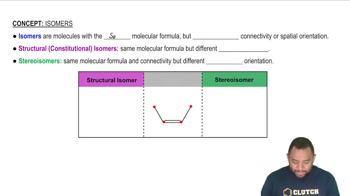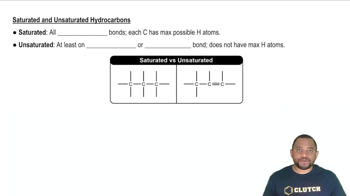Here are the essential concepts you must grasp in order to answer the question correctly.
Dienes
Dienes are organic compounds that contain two double bonds between carbon atoms. They can be classified into two main types: conjugated dienes, where the double bonds are separated by a single bond, and isolated dienes, where the double bonds are separated by more than one single bond. Understanding the structure and reactivity of dienes is crucial for predicting their chemical behavior and potential reactions.
Structural Isomers
Structural isomers are compounds that have the same molecular formula but differ in the arrangement of atoms. For C5H8, various structural isomers can be formed by altering the position of the double bonds or the carbon skeleton. Recognizing and drawing these isomers is essential for determining the total number of distinct diene structures that can exist for a given formula.
Recommended video:
Degree of Unsaturation
The degree of unsaturation indicates the total number of rings and multiple bonds in a compound. For a hydrocarbon, it can be calculated using the formula (2C + 2 - H)/2, where C is the number of carbons and H is the number of hydrogens. For C5H8, the degree of unsaturation is 3, suggesting the presence of multiple double bonds or rings, which is key to understanding the possible diene structures.
Recommended video:
Saturated and Unsaturated Hydrocarbons
 Verified step by step guidance
Verified step by step guidance
